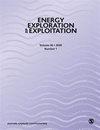Thermal evolution of deeply buried lower Paleozoic strata and its influence on hydrocarbon accumulation in the Tarim Basin, Northwest China
IF 1.6
4区 工程技术
Q4 ENERGY & FUELS
引用次数: 0
Abstract
The Ordovician carbonate reservoirs in the Tarim Basin are hotspots for oil and gas exploration in recent years. However, due to the lack of effective paleo-geothermometers in carbonate formations, thermal history studies have been greatly restricted. In this study, we reconstructed thermal history of Ordovician carbonate intervals in Tarim Basin by applying clumped isotopes, equivalent vitrinite reflectance ( R中国西北塔里木盆地深埋的下古生界地层的热演化及其对油气聚集的影响
塔里木盆地奥陶系碳酸盐岩储层是近年来油气勘探的热点。然而,由于碳酸盐岩层缺乏有效的古地温计,热史研究受到很大限制。在本研究中,我们采用团块同位素、等效玻璃光泽反射率(Requ)和锆石(U-Th)/He 年龄作为热指标,重建了塔里木盆地奥陶系碳酸盐岩层段的热历史。模拟结果表明,顺图郭勒低隆起热流演化分为三个阶段。(a) 奥陶纪-石炭纪逐渐冷却阶段。这一时期热流逐渐减小。(b) 二叠纪早期的快速上升阶段。这一时期,顺北、顺坨地区热流迅速上升,最大值为 51-65 mW/m2,但顺南地区 SN3 井热流略有上升,其他单井热流值仍相对稳定。(c) 中二叠世以来的衰退阶段。这一时期构造活动相对稳定,地热热流逐渐减少,但顺南地区热流高于顺北和顺坨地区。由于热演化的控制,顺图郭勒地区奥陶系碳酸盐岩储层的溶解早于大量烃类物质的形成,储层物性的改善为后期油气充填提供了充分的条件,有利于大型油气藏的保存。
本文章由计算机程序翻译,如有差异,请以英文原文为准。
求助全文
约1分钟内获得全文
求助全文
来源期刊

Energy Exploration & Exploitation
工程技术-能源与燃料
CiteScore
5.40
自引率
3.70%
发文量
78
审稿时长
3.9 months
期刊介绍:
Energy Exploration & Exploitation is a peer-reviewed, open access journal that provides up-to-date, informative reviews and original articles on important issues in the exploration, exploitation, use and economics of the world’s energy resources.
 求助内容:
求助内容: 应助结果提醒方式:
应助结果提醒方式:


